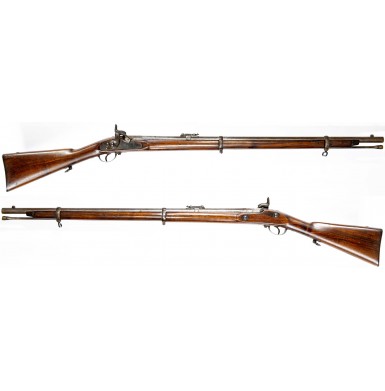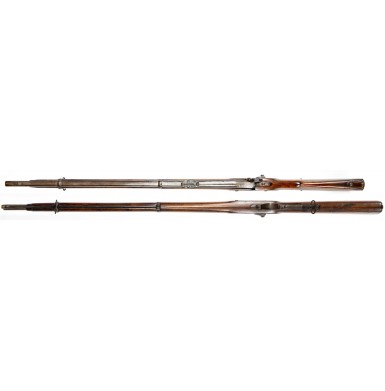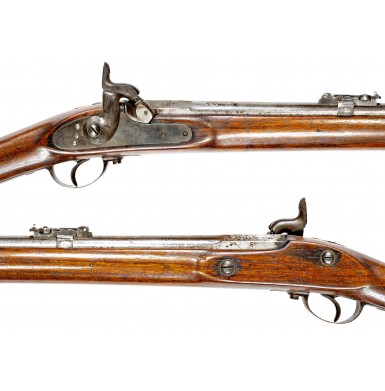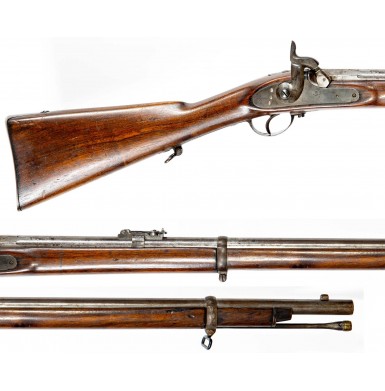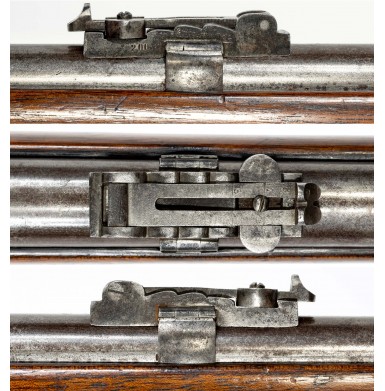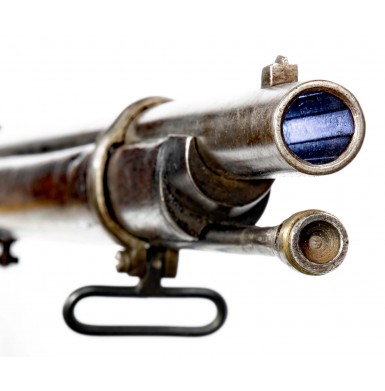Rare 1861 Dated Spanish Modelo 1857/59 Rifle - A Likely Confederate Import Arm
- Product Code: FLA-3192-SOLD
- Availability: Out Of Stock
-
$1.00
During the latter part of the 1850s, the Spanish military adopted a family of .577 caliber, percussion-ignition, muzzleloading long arms that were based upon the British Pattern 1853 “Enfield” series of arms. Like the British, the Spanish adopted both long barreled infantry rifle muskets, shorter barreled rifles, as well as a variety of specialty troops arms that included carbine models for use by cavalry and artillery, and some specialty rifles for engineers and marines. The two patterns that were produced in the largest numbers were the Carabina Rayada Modelo 1857 (Short Rifle Model 1857) and the Fusil Rayado Modelo 1859 (Long Rifle Model 1859). These two models closely resembled the British Pattern 1856 Enfield Short Rifle and the Pattern 1853 Type III Long Enfield Rifle Musket, respectively. Both had blued barrels, color case hardened locks and walnut stocks. The Modelo 1859 was a “three band”, full-length rifle musket that had a 39.25-inch barrel and an overall length of 54.5”. Unlike the British long Enfield, the Spanish model was iron mounted rather than brass mounted, had its lower swivel screwed into the toe of the stock, rather than attached to the triggerguard bow, and the ramrod had a brass band around its head to protect the rifling in the barrel. The rear sight of the M1859 was attached via a clamping band around the barrel, rather than soldered to the barrel like its British counterpart.
The Modelo 1857 rifle was also iron mounted and even more closely resembled the British P1856 from which its design was derived. The two most obvious differences were the use of the clamping rear sight and the lack of a saber bayonet lug, as the M1857 used an angular socket bayonet, like the musket, rather than a saber bayonet. As originally produced, the short rifle’s rear sight had rather tall side wall, but in 1859 the graduations for the rear sight were changed and after 1860 the rifles were produced with a rear sight with lower walls. It is likely that the change was the result of upgraded powder that allowed for a flatter projectile trajectory. A similar change was made in the latter part of the 1850s to Harpers Ferry rifled and long-range sighted Model 1841 Mississippi Rifles, whose sights were re-graduated for essentially the same reason. The British also changed the graduations for the P1853 rear sight after an improvement in gun powder quality and efficiency, with the sights being changed from 900-yard to 1,000-yard sights. Some additional minor changes in the design of the lock mechanism, in addition to the sight change, have led collectors to refer to these rifles as M1857/59. The M1857 remained in service as a front line arm until 1867, when a Berdan based cartridge alteration to the design was adopted, resulting in the M1857/67. As the transition to cartridge firearms continued over the next decade, the M1857, M1857/59 and M1857/67 all remained in service until fully replaced by the Spanish Rolling Block Rifles. As with most of the European colonial powers, the M1857 and M1857/59 saw its longest service in the various Spanish colonial holdings. In places like Cuba and the Philippines, the muzzleloading rifles remained in service well into the cartridge period of the latter part of the 19th century.
The Spanish M1857 and M1857/59 has long had a Civil War association, with indication of their importation and use by the Confederate south, albeit in relatively small numbers. Most of the early war purchases are associated with the Kentucky “Orphan Brigade”, while the later war purchases appear to have entered the Confederacy in Texas, having passed through Mexico on the way. Some good period documents discuss the various acquisitions by southern buyers, and the US government sold at least 392 surplus “Spanish Rifles” during the early 1880s that appear to have been captured from the Confederacy. One particularly interesting reference to the rifles appears in the Spanish newspaper La Iberia. The article, published on July 1, 1864 refers to the use of the Spanish Rifles both by Spanish colonial troops and their acquisition by Confederate buyers. The article reads in part:
“Units of the Spanish Army in Cuba are currently equipped with expensive and inefficient Liège rifles, while La Euscalduna (a Spanish arms contractor) has to sell their precision weapons to the Confederate South Commissioners, eager to buy them.”
It was arms collector, researcher and author William B Edwards who first proposed that the Spanish Modelo 1857/59 Rifle saw service during the Civil War. In his seminal work Civil War Guns Edwards classifies this rifle as being used during the war but hypothesizes that it was used by US troops. In the best current works on Civil War used imported guns, Firearms from Europe Second Edition by Hartzler, Whisker, Yantz & Noe, and European Arms in The Civil War by Schwalm & Hofmann strong documentation is provided that these rifles may well have been purchased by the Confederate government.
In a letter sent to Confederate arms purchasing agent Theodore Lewis, dated July 19, 1861 from CS agents W.G. Betterton & J.E. Chalard. 6,500 “Spanish Enfields” were reported to be in Havana, Cuba and ready for shipment to the Confederacy at a price of $13.00 per gun. However, the paper trail does not end there. While this letter does not confirm the importation of the guns, only their availability, the following is concrete evidence that at least a handful of these guns entered America and were eventually sold as surplus by the Federal government. Whether these surplus guns were US purchases or captured CS purchases we do not know, but this research proves beyond a shadow of a doubt that at least a few of the Spanish made the rifles made landfall in America.
The following documentation comes from the National Archives and was kindly provided to me by Civil War import arms researcher and author David Noe. All of the following comes from government publication R6 156-124, better known as Abstract of Reports of Sales of Ordnance Stores: 1864-1907. Within these reports the following listings were found for:
.577 Spanish Rifles:
September 27, 1880: 56 pieces were sold @ $.35 each to Francis Bannerman, all listed as "Unserviceable". (Volume 5, page 373)
October 25, 1881: 1 piece was sold to S.R. Starr for $1.00, listed as "Unserviceable". (Volume 6, page 27)
December 3, 1881: 334 pieces were sold @ $.78 each to Simon Belcher, all listed as "New & Serviceable". (Volume 6, page 38)
One other gun is listed as being sold to Charles Townsend for $1.00, also unserviceable. (Volume 6, page 217)
The information above indicates that for whatever reason, the United States government was in possession of at least 392 “Spanish Enfields” after the conclusion of the American Civil War.
However, there is some more new evidence that helps establish even further the connection between Spanish Rifles and the Confederacy. A number of long-time collectors and researchers have long postulated that the Confederacy received at least two batches of these Spanish rifles. The first batch in late 1861 or early 1862 has always been associated with the famous Orphan Brigade from Kentucky. The Orphan Brigade was a collection of regiments from Kentucky that were mustered into Confederate service. Because the state of Kentucky never officially joined the Confederacy, these regiments were considered “orphaned” as these soldiers fought for the Confederacy without the support of their home state. The brigade included the 2nd, 3rd, 4th, 5th, 6th & 9th Kentucky volunteer infantry regiments. These guns are inevitably dated1861 on the lock and have a serial number under about 500 on the lock, stock and breech. The second group of rifles appears to have entered the Confederacy in late 1863 or 1864 and are typically 1863 dated. These guns have higher serial numbers, typically in the, mid-3,000 to mid-4,000 range. We have direct documentation of at least some of these later imports from the Official Records of the War of Rebellion.
In a letter dated December 22, 1863, CS Major General Bankhead McGruder reported from his headquarters in Texas that “300 Spanish Rifles” had been recently received. These would have likely been the 1863 dated guns that collectors encounter today. However, the O.R.s shed little light on the earlier importation of the guns, and this is what I have spent some more time researching.
The association with the 1861 dated Spanish Enfields and the Orphan Brigade originated with an ID’d Spanish M1857/59 rifle that is concretely attributed to a member of Colonel Hiram Hawkins 5th Kentucky infantry. Hawkins helped to establish the 5th Kentucky Infantry, CSA and eventually became the Colonel of the Regiment. Hawkins also helped to outfit the unit out of his own pocket, including the purchase of a number of imported rifles. While no history of the unit officially identifies these guns, there is much circumstantial evidence that there were a number of Spanish Enfields included in that purchase. In addition to the ID’d extant example, there have been a number of the Spanish Enfields that have surfaced in Kentucky, and typically with a strong provenance and family story of Confederate Civil War use. These guns tend to appear in two states of condition: quite good or fairly rough. This is easily explained by the fact that the original 5th KY was mustered out of service on October 20, 1862. The unit was then reformed, and the original members were offered the option to go home with an honorable discharge, re-join the newly reformed 5th KY or join another of the many CS units that were being formed in Kentucky at that time. This explains the very good condition guns, as they likely went home with the soldiers who opted out; the ID’d gun in a private collection has this story associated with it. The guns of the men who stayed to fight further would necessarily show significantly more wear than the guns that went home in the fall of 1862. The final piece of the puzzle as to why Hawkins purchased Spanish guns was recently revealed while doing some research on the Orphan Brigade – that puzzle piece is William Preston.
Preston, who would eventually serve as the division commander for the 5th KY, was a Kentuckian who had a long pre-Civil War political and military service record. Preston served with distinction in the Mexican War as Lt. Col of the 4th KY volunteers. After the war he entered politics and became a very powerful and well-known Whig politician in Kentucky. When the Whig party dissolved, Preston joined the Democratic Party and threw his political support to Democratic Presidential candidate James Buchanan. After his election as President, Buchanan repaid Preston by making him the Minister to Spain, and for the next few years Preston was based in Madrid, Spain. In fact, Preston was on his way back to American when the war broke out. A quick search of the Official Records shows that with the coming of the war, the Confederate government relied on Preston to help them establish contacts in Spain for the acquisition of arms. While Preston was skeptical about the availability and quality of Spanish arms, he appears to have been more than willing to help the Confederacy obtain whatever arms were available from Spain. Additional records reveal that Preston returned to the southern states via Cuba. This dovetails with the letter from Cuba and the timeline works out well. All of this circumstantial evidence provides strong support for the stories about Confederate used Enfield pattern rifles that were manufactured in Spain and used by Kentucky troops during the first part of the Civil War.
The Spanish Modelo 1857/59 Enfield Rifle offered here is one of those early, 1861 dated guns with a low serial number, under 500. The gun is in about VERY GOOD condition overall. The lock is smooth with a mottled gray patina and some minor traces of its original color casehardened finish and works correctly on all positions. Like most European percussion locks of the period, the half-cock notch is quite low, just barely above the percussion cone. The lock is marked with the serial number 223 vertically at the tail and with the typical Spanish marks forward of the hammer, consisting of a {CROWN} / MADRID / 1861. The interior of the lock is also numbered 223. The left angled breech flat is marked with Spanish proof marks, as well as the matching serial number 223. The interior of the hammer neck is also numbered 223. While the stock of these rifles are usually numbered vertically on the obverse vertically in the middle of the butt, this one is not and does appear to have ever been so numbered. The gun retains its very unique long-range rear sight, which is attached to the barrel by clamping, rather than being screwed or soldered. These odd sights are often missing when these rare guns are encountered today. The sight is in very good condition and fully functional. The barrel has a lightly cleaned pewter gray and shows some scattered patches of darker, oxidized age discoloration. The barrel is mostly smooth over most of its surface, with only some lightly scattered peppering and pinpricking present scattered here and there. The breech area of the rifle shows more moderate pinpricking and light pitting, the result of the caustic wear from the mercuric percussion cap flash. The butt plate and the balance of the iron hardware have a similarly grayish pewter patina as the barrel, showing only some lightly oxidized brownish discoloration, and some lightly scattered surface pinpricking as well. The buttplate shows some brownish, hardened old oil residue. The bore of the gun is in about VERY GOOD condition and retains strong, four-groove rifling throughout. The bore is partly bright with scattered areas of oxidized darkness, patches of dirt and debris and some light to moderate pitting scattered along its entire length. The more moderate areas of pitting are in patches here and there. The bore measures about .58, and is nominally 24-bore, just very close to the typical Pattern 1853 Enfield. The gun retains its original rear sling swivel in the toe of the stock at the rear of the iron triggerguard tang, but the upper swivel is a modern replacement. Both of the protective screw retention nuts are missing from the barrel band tension screws. The original ramrod is missing from the gun. In its place is an interesting and likely period replacement. The rod is a repaired Austrian M1854 Lorenz ramrod. The rod has been extended by hammer welding part of another rod to it, about 6 ½” from the tip. The Austrian swell is missing from the rod, but the rod is exactly the correct length and is threaded at the end for cleaning implements and tools. The original musket-style combination front sight and bayonet lug is in place on the top of the barrel, near the muzzle. The stock is in about VERY GOOD condition as well. The stock has been lightly sanded with some rounding to the sharp edges and has some added oil finish that is attractive and highlights the grain of the wood. The stock is full-length and free of any breaks or major repairs. There is a repaired chip behind the breech plug tang where the original piece of wood has been glued back into place. This is almost certainly from the barrel being removed from the stock incorrectly. There is also some minor chipping around the edges of the lock mortise, likely from improper lock removal. As would be expected there are scattered bumps, dings and mars along with some surface scuffs and minor scratches here and there.
Overall, this is a solid example of one of the rarer Civil War import long arms to see use during the war. These Spanish Enfield rifles do not appear for sale very often and the 1861 dated, low serial number guns that could legitimately be Orphan Brigade guns rarely appear on the collector market. Over the years I have had a total of ten Spanish M1857 or M1857/59 Enfield Rifles in the past 15 years or so, and only five of which were the early, 1861 dated guns. This is a very nice looking and displaying rifle, that retains the original long range rear, a part that is often missing from these guns. Although the original ramrod is missing, the replacement rod is almost certainly a period of use replacement that is very cool and displays wonderfully. Interestingly of the ten rifles I have had, only four have had the original ramrod. These potentially Confederate imported Spanish Enfield contract rifles are a real rarity that deserve a special place of honor in any advanced collection of Civil War import arms, especially a collection that focuses on Confederate imports. The last one of these I had sold fairly quickly, so don’t miss your chance to get one of these very scarce rifles to add to your Confederate import weapons display.
SOLD
Tags: Rare, 1861, Dated, Spanish, Modelo, 1857/59, Rifle, A, Likely, Confederate, Import, Arm


